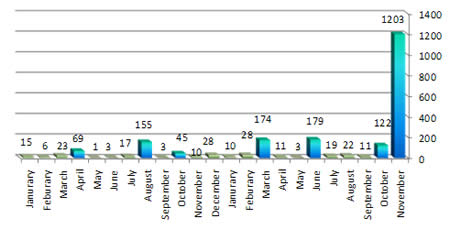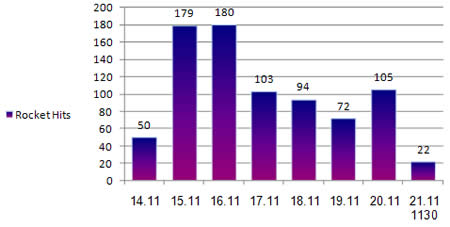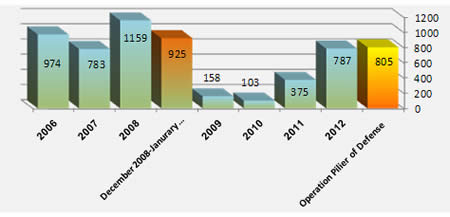Overview
1. During the past 24 hours there was an increase in the amount of and lethal damage done by rocket fire from the Gaza Strip (two Israelis were killed, a soldier and an employee of the Ministry of Defense). Three long-range rockets were fired into Israel, one targeting the Israeli city of Rishon Letzion (13 kilometers, or eight miles, south of Tel Aviv) which caused extensive damage to a residential dwelling and two which hit south of Jerusalem. In addition, a bomb exploded on a bus in the heart of Tel Aviv, wounding 23 civilians, one of them critically. In our assessment, all of the above were terrorist organization attempts to create a "myth of victory" before a possible ceasefire went into effect.
2. In the past 24 hours IDF forces conducted intensive attacks which escalated overnight. The attacks concentrated on terrorist infrastructures and operatives, rocket-launching squads and Hamas administration sites (the ministry of internal security, a police patrol facility, tunnels used to smuggle fuel into the Gaza Strip).
3. Political contacts, with the participation of American Secretary of State Hillary Clinton, led to a ceasefire which went into effect at 2100 hours, November 21, 2012.
Terrorist Bombing of a Bus in Tel Aviv
4. According to initial reports, at 12 noon on November 21 a bomb exploded on a bus in the heart of Tel Aviv. The police are of the opinion that the bomb was placed under a seat. Police forces are searching for the perpetrators.
5. Twenty-three Israelis were wounded in the bomb attack, one of them critically, one seriously and the rest incurred minor injuries. All the casualties were evacuated to nearby Ichilov Hospital.
Rocket Fire into Israel
6. During the past 24 hours rocket fire into Israel has increased, both in quantity, casualties, and property damage. In our assessment, the increase stems from the Palestinian terrorist organizations' desire to create a "myth of victory," especially in view of the recent announcements regarding an approaching ceasefire. Most of the rocket fire has targeted Israel's big cities; the number of hits and casualties were relatively greater than during the preceding days. Two Israelis (a soldier and a civilian) were killed. A reserve soldier and a civilian were critically wounded.
7. Worst hit was the city of Rishon Letzion, south of Tel Aviv. At approximately 1800 hours a long-range rocket struck the sixth floor of an apartment building. The rocket caused extensive damage to the building, to neighboring buildings and to cars parked in the street. Four civilians were wounded. It was the first time a long-range rocket had caused significant damage to a building in the greater Tel Aviv area.
8. Other serious attacks on November 20 were the following:
1) Beersheba: During the morning a barrage of rockets was fired at the city. One of them hit a residential dwelling. Earlier in the day rockets hit a bus, cars, a soccer field and a number of buildings.
2) Jerusalem: At 1413 hours two long-range rockets were launched toward Jerusalem. One fell in Gush Etzion, south of the city. The other hit the Hebron region. There were no casualties and no damage was reported.
3) In the afternoon a factory in the western Negev took a direct hit. Another rocket hit a building in a town north of the Gaza Strip.
4) Ashdod: At 1600 hours a barrage of rockets was fired at the southern city of Ashdod. One hit a building. Four rockets were intercepted and destroyed by the Iron Dome aerial defense system. At around 0300 hours on the night of November 20,six rockets were fired at Ashdod, two of which were intercepted and destroyed by the Iron Dome. The others fell in open areas.
9. During the morning of November 21, while efforts were being made to achieve a ceasefire, rocket fire from the Gaza Strip continued. A number of salvos were fired at Ashqelon, and rockets were fired at Beersheba, towns and villages in the northwestern Negev (where a house took a direct hit) and elsewhere in the area.
Statistical Data
10. During the past 24 hours 105 rocket hits were identified in Israeli territory. On the morning of November 21 (as of 1130 hours) 22 rocket hits had been identified. Of the rockets fired on the November 20, three were long-range rockets (two targeting Jerusalem and one Rishon Letzion) Since the beginning of Operation Pillar of Defense 805 rockets have hit Israel and more than 1,300 have been fired.
Rockets Hits in Israeli Territory since the Beginning of 2011

Note: The graph clearly illustrates the rounds of escalation and their increasing frequency during the six months until Operation Pillar of Defense. It includes 805 rocket hits identified during the operation, which still continues.
Daily Distribution of Rocket Hits in Israel's South since the Beginning of Operation Pillar of Defense

– As of November 21, 1130 hours.
– So far 805 rocket hits have been identified in Israeli territory and more than 1,300 have been fired.
– Twelve long-range rockets(of more than 40 kilometers, or 25 miles) were fired. Eight either fell or were intercepted in the greater Tel Aviv area and three in the Jerusalem area.
Annual Distribution of Rocket Fire since the Hamas Takeover of the Gaza Strip

*Based on an estimated 805 rocket hits as of 130 hours, November 21.
Claiming Responsibility for Rocket and Mortar Shell Fire
11. Hamas continues to claim responsibility for most of the rocket fire, followed by the PIJ. Other organizations have also made claims, such as the Popular Resistance Committees, the Popular Front for the Liberation of Palestine, the Democratic Front for the Liberation of Palestine, the Al-Aqsa Martyrs Brigade and various networks affiliated with the global jihad (Websites of the organizations).
IDF Activity
Air Strikes on the Gaza Strip
12. During the past 24 hours the IDF continued attacking terrorist targets in the Gaza Strip. Since the beginning of the operation more than 1,500 terrorist targets have been struck. On the night of November 20 air strikes were intensified. The IDF made a specific effort to target sites belonging to the de-facto Hamas administration. Among the targets hit on November 20-21 were the following (IDF Spokesman, November 20-21, 2012):
1) Terrorist infrastructure: On the night of November 20 the offices of Hamas' military intelligence located in the Gaza Strip's communications center,[1]were attacked. In addition, a military hideout in the southern Gaza Strip was attacked, which served as a communications center and meeting place for terrorist operatives. Other terrorist targets attacked were terrorist cells, about 50 underground rocket launchers, tunnels used for terrorist activities, three weapons stockpiles and a site used for the manufacture of weapons.
2) Terrorist Operatives: A senior member of Hamas' aerial defense system was attacked. According to the IDF Spokesman, so far more than 70 terrorist operatives have been targeted. On the evening of November 20 a PIJ site of terrorist activity was attacked, during which Yunis Shalouf was killed, the operative responsible for firing rockets at Eilat, Israel's southernmost city, a number of months ago.
3) Rocket-launching squads: Among those targeted were a squad in the At-Atatra neighborhood of Beit Lahia in the northern Gaza Strip and another which fired rockets from Jabalia. In the afternoon a terrorist operative was attacked after being identified at the site from which rockets had been fired at Jerusalem on November 20. A squad which was preparing to fire an anti-tank missile was also attacked.
4) Hamas governmental sites: The ministry of internal security and a central police patrol facility were attacked, as were tunnels used to smuggle fuel into the Gaza Strip. Four fuel pipelines, a significant source of revenue for Hamas, were also attacked.
Israeli Navy Activity
13. While the Israeli Air Force attacked from the air, the Israeli Navy also attacked terrorist targets along the Gazan coast. On November 21 a rocket-launching site, a post and a building used by Hamas terrorist operatives were hit (IDF Spokesman, November 21, 2012).
[1] Military offices in the Gaza Strip are sometimes situated in buildings which serve communications networks.










